 W
WThis list of World War I memorials and cemeteries in Flanders describes some of the war cemeteries and memorials erected in Flanders to mark events there during World War I. By the end of 1914 the Western Front ran from Nieuwpoort on the North Sea Coast to the Swiss Border. After the war, many memorials were erected in and along the area through which the front line had run, and below is a record of some of these memorials. Most of the war memorials in Flanders can be found in the Province of West Flanders (West-Vlaanderen), which comprises the arrondissements of Bruges, Diksmuide, Ypres, Kortrijk, Ostend, Roeselare, Tielt and Veurne.
 W
WAdinkerke Military Cemetery is a Commonwealth War Graves Commission (CWGC) burial ground for the dead of the Western Front of the First and Second World War. It is located near Adinkerke in the municipality of De Panne in western Belgium, close to the French border. The cemetery is surrounded by farmland and can only be reached via a 50-metre grassed path which is not suitable for vehicles.
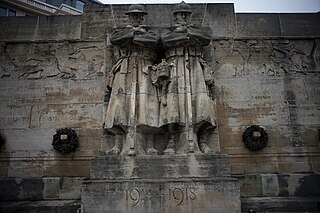 W
WThe Anglo-Belgian War Memorial is a monument in Brussels, Belgium, which was commissioned by the British Imperial War Graves Commission and designed by the British sculptor Charles Sargeant Jagger (1885–1934).
 W
WThe Buttes New British Cemetery Memorial is a World War I memorial, located in Buttes New British Cemetery, near the town of Zonnebeke, Belgium. It commemorates 378 officers and men of the New Zealand Division who were killed in the vicinity and have no known grave.
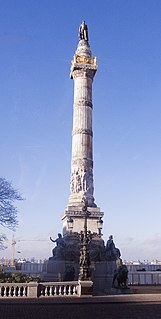 W
WThe Congress Column is a monumental column situated on the Place du Congrès/Congresplein in Brussels, Belgium, which commemorates the creation of the Constitution by the National Congress of 1830–1831. It was erected between 1850 and 1859, on the initiative of Charles Rogier according to a design by Joseph Poelaert, and was inspired by Trajan's Column in Rome. At the top of the column is a statue of Belgium's first monarch, King Leopold I, and the pedestal is surrounded by statues personifying the four freedoms guaranteed under the Constitution, while the Belgian Tomb of the Unknown Soldier lies at the foot of the column.
 W
WThe Dodengang is a World War I memorial site located near Diksmuide, Belgium. The site is located about 1.5 kilometres (0.93 mi) from the Ijzertoren in the centre of the city, and set directly on the banks of the Yser Canal.
 W
WFlanders Field American Cemetery and Memorial is a World War I cemetery on the southeast edge of the town of Waregem, Belgium. The memorial was designed by architect Paul Cret. This is the only American World War I cemetery in Belgium and 411 American servicemen are buried or commemorated there. Many of them fell at Spitaals Bosschen, an action of the Ypres-Lys Campaign by the 91st Infantry Division in the closing days of World War I.
 W
WGrootebeek British Cemetery is a Commonwealth War Graves Commission (CWGC) burial ground for the dead of the Western Front of the First and Second World War. It is located near Reningelst in the municipality of Poperinge in western Belgium. The cemetery is surrounded by farmland and can only be reached via a 100-metre grassed path which is not suitable for vehicles.
 W
WHill 60 is a World War I battlefield memorial site and park in the Zwarteleen area of Zillebeke south of Ypres, Belgium. It is located about 4.6 kilometres (2.9 mi) from the centre of Ypres and directly on the railway line to Comines. Before World War I the hill was known locally as Côte des Amants. The site comprises two areas of raised land separated by the railway line; the northern area was known by soldiers as Hill 60 while the southern part was known as The Caterpillar.
 W
WThe Canadian Hill 62 Memorial is a war memorial that commemorates the actions of the Canadian Corps in defending the southern stretches of the Ypres Salient between April and August 1916 including actions in battle at the St Eloi Craters, Hill 62, Mount Sorrel and Sanctuary Wood. These battles marked the first occasion in which Canadian divisions engaged in planned offensive operations during World War I. In those actions the Canadians reconquered vital high-ground positions that denied the Germans a commanding view of the town of Ypres itself.
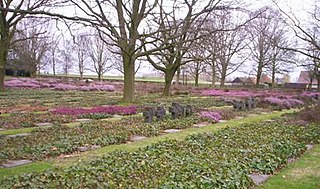 W
WThe Hooglede German war cemetery is a military cemetery in the Belgian town of Hooglede, six kilometer northwest of Roeselare. It is located at the east side of Hooglede. It contains 8,241 buried German soldiers from World War I.
 W
WThe Infantry Memorial of Brussels stands in memory of the Belgian foot soldiers who fought in World War I and World War II. Designed by Edouard Vereycken, the memorial stands in front of Brussels' Palace of Justice and across the Place Poelaert/Poelaertplein from the Anglo-Belgian War Memorial. The memorial rests on a raised platform that overlooks Brussels' city centre. Translated into English, the inscription reads: "To the infantrymen who died for their country".
 W
WThe Island of Ireland Peace Park and its surrounding park, also called the Irish Peace Park or Irish Peace Tower in Messines, near Ypres in Flanders, Belgium, is a war memorial to the soldiers of the island of Ireland who died, were wounded or are missing from World War I, during Ireland's involvement in the conflict. The tower memorial is close to the site of the June 1917 battle of Messines Ridge, during which the 16th (Irish) Division fought alongside the 36th (Ulster) Division.
 W
WLijssenthoek Military Cemetery is a Commonwealth War Graves Commission (CWGC) burial ground for the dead of the First World War in the Ypres Salient on the Western Front. After Tyne Cot, it is the second largest cemetery for Commonwealth forces in Belgium. Lijssenthoek Military Cemetery is located near Poperinge in the province of West Flanders. Most of those buried in the cemetery are war casualties who had been wounded near Ypres and later died in the four large Allied casualty clearing stations located in this area.
 W
WThe Menen German war cemetery is a military cemetery in the Belgian town of Menen territory and partly in Wevelgem. There were nearly 48,000 German soldiers buried from the First World War, making it the largest in Flanders. In between are several crosses and oak and chestnut trees. In the center is an octagonal memorial chapel.
 W
WThe Menin Gate Memorial to the Missing is a war memorial in Ypres, Belgium, dedicated to the British and Commonwealth soldiers who were killed in the Ypres Salient of World War I and whose graves are unknown. The memorial is located at the eastern exit of the town and marks the starting point for one of the main roads out of the town that led Allied soldiers to the front line. Designed by Sir Reginald Blomfield and built by the Imperial War Graves Commission, the Menin Gate Memorial was unveiled on 24 July 1927.
 W
WThe Messines Ridge Memorial is a World War I memorial, located in Messines Ridge British Cemetery, near the town of Mesen, Belgium. The memorial lists 827 officers and men of the New Zealand Expeditionary Force with no known grave who died in or near Messines in 1917 and 1918. This period included the Battle of Messines.
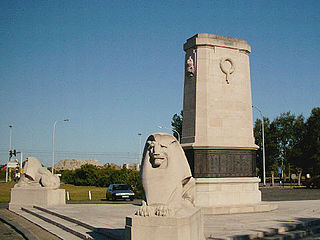 W
WThe British Nieuport Memorial is a First World War memorial, located in the Belgian port city of Nieuwpoort, which is at the mouth of the River Yser. The memorial lists 547 names of British officers and men with no known grave who were killed in the Siege of Antwerp in 1914 or in the defence of this part of the Western Front from June to November 1917. Those that fought in 1914 were members of the Royal Naval Division. The fighting in 1917, when XV Corps defended the line from Sint-Joris to the sea, included the German use of chemical weapons such as mustard gas and Blue Cross.
 W
WThe Passchendaele Canadian Memorial is a Canadian war memorial that commemorates the actions of the Canadian Corps in the Second Battle of Passchendaele of World War I. The memorial is located on the former site of Crest Farm, an objective captured by the 4th Canadian Division during the assault of 30 October 1917.
 W
WThe Ploegsteert Memorial to the Missing is a Commonwealth War Graves Commission (CWGC) memorial in Belgium for missing soldiers of World War I. It commemorates men from the Allied Powers who fought on the northern Western Front outside the Ypres Salient and whose graves are unknown. The memorial is located in the village of Ploegsteert and stands in the middle of Berks Cemetery Extension.
 W
WPolygon Wood is a forest located between Ypres and Zonnebeke, West Flanders, Belgium. It was the scene for several battles during the First World War and there are at least two cemeteries of the Commonwealth War Graves Commission in the immediate vicinity of the wood.
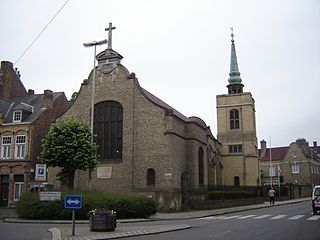 W
WSaint George's Memorial Church, Ypres, Belgium, was built to commemorate over 500,000 British and Commonwealth troops, who had died in the three battles fought for the Ypres Salient, during World War I. It was completed in 1929.
 W
WThe St. Julien Memorial is a Canadian war memorial and small commemorative park located in the village of Saint-Julien, Langemark, Belgium. The memorial commemorates the Canadian First Division's participation in the Second Battle of Ypres of World War I which included fighting in the face of the first poison gas attacks along the Western Front. Frederick Chapman Clemesha's sculpture, the Brooding Soldier, was selected to serve as the central feature of the monument following a design competition organized by the Canadian Battlefield Monument Commission in 1920.
 W
WSite John McCrae is a World War I memorial site near Ypres, Belgium. It is named after the Canadian physician Lieutenant Colonel John McCrae, MD (1872–1918), author of the famous poem "In Flanders Fields", which he composed while serving at this site in 1915.
 W
WSpanbroekmolen is a small group of farms in Heuvelland, a municipality located in the Belgian province of West Flanders. The hamlet is sited on one of the highest points of the Messines Ridge, in between the villages of Kemmel, Wijtschate and Wulvergem.
 W
WThe St Symphorien Military Cemetery is a First World War Commonwealth War Graves Commission burial ground in Saint-Symphorien, Belgium. It contains the graves of 284 German and 229 Commonwealth soldiers, principally those killed during the Battle of Mons. The cemetery was established by the German Army on land donated by Jean Houzeau de Lehaie. It was initially designed as a woodland cemetery before being redesigned by William Harrison Cowlishaw after the Imperial War Graves Commission took over maintenance of the cemetery after the war.
 W
WThe Liverpool Scottish Memorial is a World War I memorial erected in Belgium in 2000. It is located in Railway Wood on the Bellewaerde Ridge near Zillebeke, about 4 kilometres east of Ypres, and a little north of Hooge. The area was the site of intensive fighting in the First World War. Near the memorial is the site of RE Grave, Railway Wood.
 W
WTyne Cot Commonwealth War Graves Cemetery and Memorial to the Missing is a Commonwealth War Graves Commission (CWGC) burial ground for the dead of the First World War in the Ypres Salient on the Western Front. It is the largest cemetery for Commonwealth forces in the world, for any war. The cemetery and its surrounding memorial are located outside Passchendale, near Zonnebeke in Belgium.
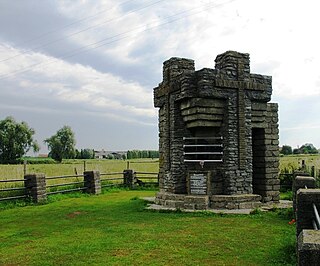 W
WEdward and Frans Van Raemdonck were siblings who were killed while serving in the Belgian Army in World War I. Born in Temse in East Flanders, both brothers had volunteered for the Belgian Army in 1914. They were serving together in the 6th Company of the 24th Line Regiment when both were killed in an attack on the hamlet of Stampkot, near Steenstrate, on the night of 25–26 March 1917, aged 18 and 17 respectively. In the aftermath of the conflict, the deaths of the "Van Raemdonck brothers" became part of Flemish popular mythology as a result of its symbolism of brotherly love and self-sacrifice. Their flamingant views and the supposed indifference to their fate among their French-speaking officers meant that it became increasingly associated with the Flemish Movement in post-war Belgium. Their fate was widely commemorated in monuments over following years and the brothers were symbolically reburied at the Yser Towers (IJzertoren) monument in 1932 and was an important part of the annual Yser Pilgrimage (IJzerbedevaart).
 W
WVladslo German war cemetery is about three kilometres north east of Vladslo, near Diksmuide, Belgium. Established during World War I, the cemetery holds 3,233 wartime burials. In 1956, burials from many smaller surrounding cemeteries were concentrated in Vladslo, and it now contains the remains of 25,644 soldiers. Each stone bears the name of twenty soldiers, with just their name, rank, and date of death specified.
 W
WThe Welsh National Memorial Park is a war memorial in Langemark near Ypres (Belgium) for soldiers of World War I, located near the Pilkem Ridge in the former Ypres Salient. It commemorates the services of men and women from Welsh origin(Wales), wherever they served during the Great War as part of the Allied Powers, as well as the non-Welsh soldiers serving in Welsh formations.
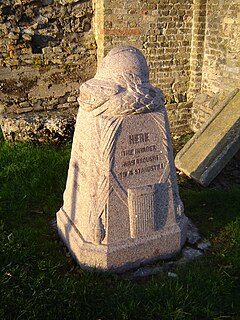 W
WWestern Front demarcation stones, also known as Bornes du Front and Bornes Vauthier, are monuments erected in France and Belgium to mark the limit of the German advance during the First World War. The stones were the idea of sculptor Paul Moreau-Vauthier, a veteran of the war, and were erected between 1921 and 1930. The total number of stones erected is unclear but it is thought that there were 118 official stones, of which 93 survive. The stones identify the army that held that sector in 1918 and are engraved with the text "Here the invader was brought to a standstill 1918" in English, Dutch, and French.
 W
WYpres is a Belgian municipality in the province of West Flanders. Though the Dutch Ieper is the official name, the city's French name Ypres is most commonly used in English. The municipality comprises the city of Ypres and the villages of Boezinge, Brielen, Dikkebus, Elverdinge, Hollebeke, Sint-Jan, Vlamertinge, Voormezele, Zillebeke, and Zuidschote. Together, they are home to about 34,900 inhabitants.
 W
WThe Yser Towers are a monument near the Yser river at Diksmuide in Belgium. It was built to commemorate the soldiers killed on the Yser Front in World War I and pacifism but subsequently became an important political symbol for the Flemish Movement. The original monument was constructed in 1930 but was destroyed in 1946 as a result of its political associations with Flemish nationalist collaboration after World War II. The current tower was rebuilt alongside the remains of the original and was finished in 1965. It remains a site of political significance to Flemish nationalists and is the center for their annual Yser Pilgrimage (IJzerbedevaart).